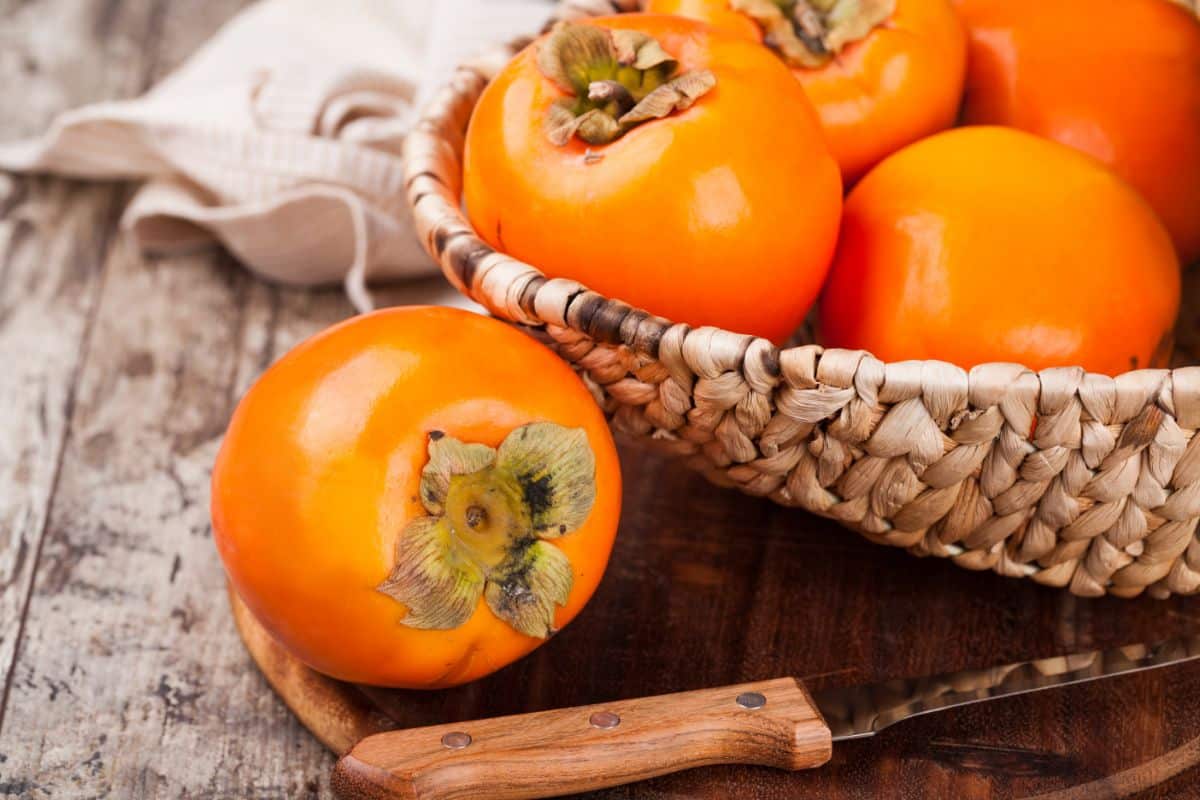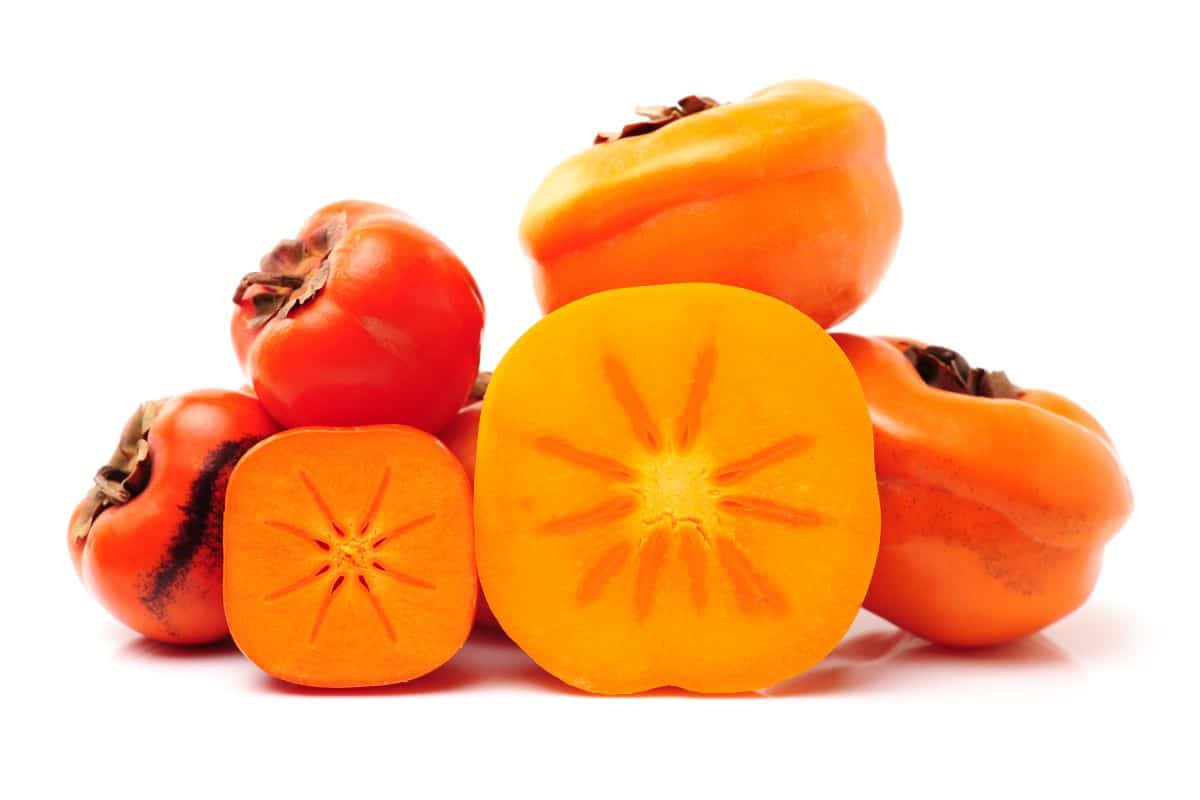If you’re curious about what a persimmon tastes like, you’re in the right place as, in this article, we’ll explore the flavor profile of persimmons and give you a detailed answer to this age-old question.

From their nutritional benefits to some recipe ideas to use them in, we’ll cover everything you need to know about persimmons.
So, keep reading to discover the unique taste of this delicious fruit!
What Is Persimmon?
If you haven’t had the pleasure of trying this fruit yet, you’re in for a treat!
Persimmons are small to medium-sized fruit that are native to East Asia but are now grown in many parts of the world.
They come in different shapes, sizes, and colors, but most commonly, you’ll find them in shades of orange and red.
Now, here’s the thing about persimmons; they’re not like your regular fruits. When they’re ripe, they have a soft, jelly-like texture and a sweet flavor that’s hard to describe.
In fact, some people say it tastes like a mix between apricots and honey, while others describe it as a cross between peaches and mangos.
The Flavor Profile Of Persimmon
As we mentioned earlier, persimmons are described differently by many people, so it’s hard to describe the taste of persimmons. But we’ll do our best to paint a picture for you!
When you take a bite of a ripe persimmon, you’ll notice a sweetness that’s almost caramel-like, with a hint of cinnamon and nutmeg. It’s like taking a bite of autumn in your mouth!
But that’s not all. There’s also a subtle tanginess to the fruit that balances out the sweetness. Some varieties of persimmons also have a slight bitterness, which gives it a depth of flavor.
And the texture? It’s like biting into a soft, juicy piece of heaven!
Here’s the thing about persimmons, though; they can be a little tricky to eat. If you eat them before they’re fully ripe, they can taste astringent and chalky.
But when they’re perfectly ripe, they’re a whole different story. You want to wait until the fruit is soft and almost mushy to the touch before eating them. Trust us, it’s worth the wait!
How To Eat Persimmon
Now that you know how amazing persimmons taste, you’re probably wondering how to eat them.
As we mentioned earlier, persimmons can be a little tricky to eat. But fear not, we’re here to guide you through the process!
First things first, you want to make sure you have a ripe persimmon.
As we said before, a ripe persimmon should be soft and almost mushy to the touch. If it’s still firm, let it ripen a little longer before eating.
Once your persimmon is ripe, you can eat it as is, like you would an apple or a pear. Just make sure you cut off the top and bottom of the fruit and peel away the skin.
However, you can also slice the persimmon into pieces and use it in a salad or as a topping for yogurt or oatmeal!
But if you’re feeling adventurous, you can also bake persimmons into a dessert. They’re delicious in cakes, pies, and even cookies.
Just make sure you use ripe persimmons and adjust the sweetness of the recipe accordingly, as persimmons are naturally sweet.
Examples Of Recipes That Use Persimmons
We’ve talked about how amazing persimmons taste and how to eat them, so it’s time to take it up a notch and explore some delicious recipes that use persimmons.
Persimmon Bread
First up, we have a classic: Persimmon Bread.
This sweet, moist bread is the perfect treat for breakfast or as a snack. You’ll need ripe persimmons, flour, sugar, eggs, oil, baking soda, and spices like cinnamon and nutmeg.
Mix everything together, bake it in the oven, and voila – you have a delicious treat that’s sure to impress.
Persimmon Pudding
Next, we have Persimmon Pudding. This rich and creamy dessert is a must-try for anyone who loves persimmons.
You’ll need ripe persimmons, flour, sugar, milk, and spices like cinnamon and allspice. Mix everything together, bake it in the oven, and serve it warm with a dollop of whipped cream on top. Yum!
Other Persimmon Dishes
You can also use persimmons in savory dishes, like Persimmon and Prosciutto Salad.
This fresh and flavorful salad combines ripe persimmons, arugula, prosciutto, and a tangy vinaigrette. It’s the perfect balance of sweet and salty and will leave you wanting more.
And if you’re feeling fancy, you can even make Persimmon Sorbet. This refreshing dessert is made with ripe persimmons, sugar, and lemon juice.
Blend everything together, freeze it, and enjoy a cool and creamy treat that’s perfect for a hot summer day!
The Nutritional Benefits Of Persimmon

To give you a general idea of their nutritional value, here’s a breakdown of the nutritional content of one medium-sized persimmon:
- Calories: 118
- Total fat: 0.3g
- Sodium: 2mg
- Total carbohydrate: 31g
- Dietary fiber: 6g
- Sugars: 21g
- Protein: 1g
- Vitamin A: 55% of the Daily Value (DV)
- Vitamin C: 22% of the DV
- Vitamin B6: 8% of the DV
- Potassium: 8% of the DV
However, let’s also see how a persimmon a day can contribute to your overall health and what its nutritional benefits are:
High Fiber Content
Persimmons are a fantastic source of dietary fiber which is vital for a healthy digestion and the prevention of constipation, while it can also help lower cholesterol levels and reduce your risk of heart disease and diabetes.
In fact, just one medium-sized persimmon contains about 6 grams of fiber, which is about 20% of your recommended daily intake!
Packed With Antioxidants
Persimmons are loaded with antioxidants, which are compounds that help protect your cells from damage caused by free radicals, the unstable molecules that can cause oxidative stress and contribute to chronic diseases like cancer and heart disease.
The high levels of vitamin A, vitamin C, and beta-carotene found in persimmons make them a powerful antioxidant-rich fruit that can help protect your body from oxidative stress and disease.
Good Source Of Potassium
Persimmons are also a good source of potassium, a mineral that plays a vital role in maintaining healthy blood pressure levels, and by including persimmons in your diet, you can help support healthy blood pressure levels and reduce your risk of heart disease and stroke.
Vitamin B6 For Brain Function
Persimmons are also a good source of vitamin B6, a nutrient that helps produce neurotransmitters like serotonin and dopamine that are essential for regulating mood, sleep, and appetite, and play a crucial role in maintaining healthy brain function.
By getting enough vitamin B6 in your diet, you can help support healthy brain function and reduce your risk of neurological conditions like depression and dementia.
The Bottom Line
Persimmons are a unique and delicious fruit that offer a range of health benefits.
Whether you eat them on their own, use them in a recipe, or simply enjoy their sweet and tangy flavor, persimmons are definitely worth adding to your diet.
So why not give them a try and experience their delicious taste and






